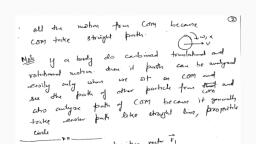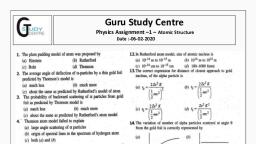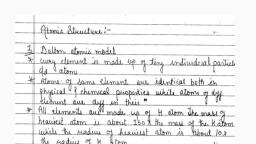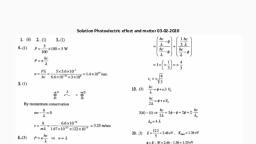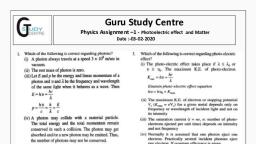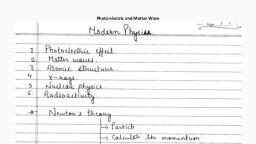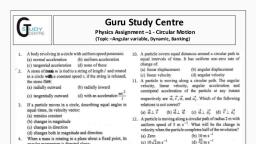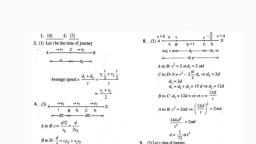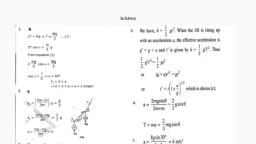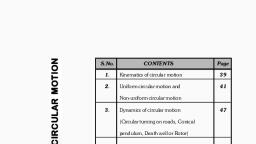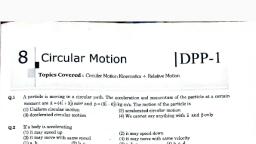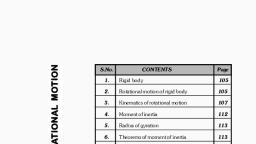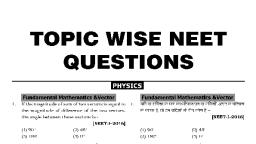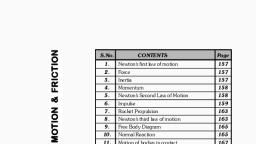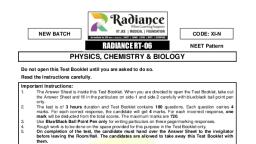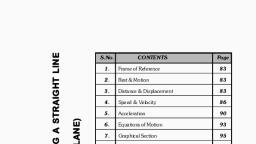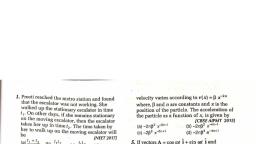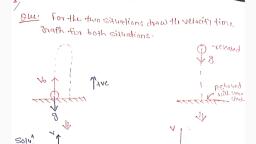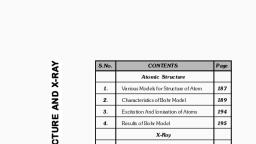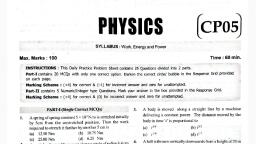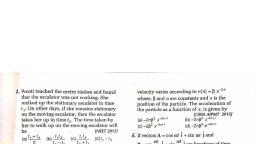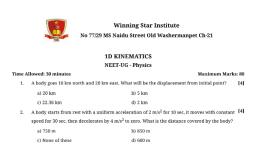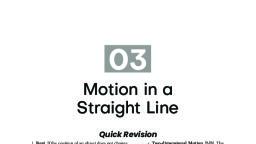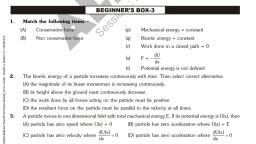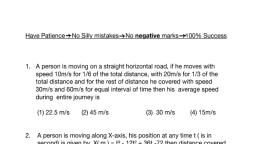Page 1 : CENTRE, , , , , , Guru Study Centre Test -9jsaten-3), , SPUDY Physics: Full Kinematics , Chemistry Electrochemistry , Equilibrium, Redox & Chemical Bonding ,, Bio-I Anatomy, Structural Organisation in Animals, Cell the Unit of Life (up to cell wall included), Bio-Il — Microbes, Principle of Inheritance & Human Health & Diseases _(Date:- 10-01-2022), , , , 1. Which of the following is a one-dimensional motion?, , (1) Landing of an aircraft, (2) Earth revolving around the sun, (3) Motion of wheels of moving train, (4) Train running on a straight track, 2. A point traversed half a circle of radius r during a time, interval fy, its mean speed and magnitude of mean velocity, , are, , aga.= Q2ZZ=, fo f fo, mr 2r 2ar r, , ra Di 7, fy t % %, , 3. A particle moving in a straight line from A to B for the, first half of time with a uniform velocity v, and for the, next half of time with a uniform velocity v). The average, velocity of the particle is, , a) a Q2) Jn, , Yi¥e 2y¥, , GB) (4), , VY +¥y Yt, 4.. A particle moving in a straight line covers half the, distance with speed vp. The other half of the distance is, covered in two equal time intervals with speed y, and v2,, respectively, The average speed of the particle during this, motion is, , (1) tO +%) gy Ao ve), Vy +My +My Voth +¥2, 2Vy (Vy + ¥2 Yo (Vy + ¥2, , (3) 24%) gy Yo tr), 2v9 + ¥; + ¥2 2vy +, + v2, , 5. Speed of two identical cars are u and 4u at a specific, instant. The ratio of the respective distances in which the, two cars are stopped from that instant is, (dsl (2) 1:4, (3) 1:8 (4) 1:16, , 6. A body A starts from rest with an acceleration a,, After, 2s, another body B starts from rest with an acceleration a., If they cover equal distances in the 5" second after the start, of A, then the ratio @; : a, is equal to, Q)5:9 (2) 5:7, G)9:5 (4) 9:7, , 7. Atrain starting from rest accelerates uniformly for 100 s,, then comes to a stop with a uniform retardation in the, next 200 s. During the motion, it covers a distance of, 3 km. Choose the wrong option, (1) Its acceleration is 0.2 m/s”, , (2) Its retardation is 0.1 m/s*, (3) The maximum velocity is 20 m/s, (4) The maximum velocity is 10 m/s, , 10., , 11., , 12., , 13., , 14., , 15., , A car, starting from rest, accelerates at the rate a through, a distance d, then continues at a constant speed for time f, and then decelerates at the rate of a/2 to come to rest. If, the total distance traveled is 15 d, then, , 1 3 fh, I)\d=—at 2d=-—ar, () 2 (2) zu, , La ba, 3)d= — 4)d=—ar, GB) mt! (4) ‘, , . Astone falls freely from rest from a height A and it travels, , a distance h/2 in the last second, The time of journey is, , () ¥2s (2) (2-V2)s, , (3) (2+V2)s (4) 2s, , When a ball is thrown up vertically with velocity «, it, attains a maximum height H, What should be the velocity, so that maximum height becomes 2H?, , (y vu (2) 2u, 3 a), (3)3u OF, , A body thrown vertically upwards with an initial velocity «, reaches maximum height in 6 s. The ratio of the distances, traveled by the body in the first second and the seventh, second is, , ()t:1 (2) 11:1, , (3)1:2 (4) 1:41, , With what velocity a ball be projected vertically so that the, distance covered by it in 5" second is twice the distance, it covers in its 6 second (g = 10 m/s”), , (1) 58.8 m/s (2) 49 m/s, , (3) 65 m/s (4) 19.6 m/s, , A ball is dropped from the top of an 80 m high tower., After 2 s another ball is thrown downwards from the, tower. Both the balls reach the ground simultaneously., The initial speed of the second ball is, , (1) 10 m/s (2) 20 m/s, , (3) 30 mvs (4) 40 mis, , Water drops fall at regular intervals from a tap which is, 5 m above the ground. The third drop is leaving the tap, at the instant the first drop touches the ground. How far, above the ground is the second drop at that instant, , (1) 2.50 m (2) 3.75m, , (3) 4.00 m (4) 1.25m, , Two balls A and B of same masses are thrown from the, top of the building. A, thrown upward with velocity v and, B, thrown downward with velocity v, then, , (1) Velocity of A is more than B at the ground, , (2) Velocity of 5 is more than A at the ground, , (3) Both A and B strike the ground with same velocity, (4) None of these, , , , GURU STUDY CENTRE (KACHERI ADDA, DHARAMSHALA DISTT. KANGRA) CONTACT US :- 8629073248, , , , 8988076292, 9882983453 EMAIL:-
[email protected], WWW.GURUSTUDYCENTRE.COM 1
Page 2 :
16. A ball is thrown vertically upwards from the top of a, tower of height 60 m with a speed of 20 m/s., (i) The ball strikes the ground after 6 s, (ii) The ball strikes the ground with speed 40 m/s, (iii) The distance of ball above the ground after 5 s is 35 m, (iv) The maximum height attained by ball above the, ground is 80 m, (1) (i), (ii) (2) (i), (ii), (ii), (3) Gi), (iv) (4) All options are correct, , 17. Two balls are projected simultaneously with the same speed, from the top of a tower, one vertically upwards and the other, vertically downwards. They reach the ground in 9 s and, 4 s, respectively. The height of the tower is (g = 10 m/s’), (1) 90m (2) 180 m, (3) 270m (4) 360 m, , 18. A body is projected vertically upwards. If 1, and f, be, the times at which it is at height h above the point of, projection while ascending and descending respectively,, then h is, Meth Qeth, B)2eth A4gnh, , 19. In the previous problem, the velocity of projection is, (1) % g(t, +h) (2) g(t; +t), , (3)2 g(t, +4) (4) 4 g(t, +h), , 20. A ball is dropped from a height of 5 m onto a sandy floor, and penetrates the sand up to 1 m before coming to rest., The retardation of the ball in sand (assuming it to be, , uniform) will be, (1) 25 mis? (2) 50 mis?, (3) 75 m/s* (4) 100 mis*, , 21. A man ina balloon, rising vertically with an acceleration, of 5 m/s’, releases a ball 10 s after the balloon is let go, from the ground. The greatest height above the ground, reached by the ball is, (1) 125 m (2) 250m, (3)375m (4) 500m, , 22. A rocket is fired upward from the earth’s surface such that, it creates an acceleration of 20 m/s”. If after 5 s its engine, is switched off, the maximum height of the rocket from, the earth's surface would be, (1) 250 m (2) 500m, (3) 750 m (4) 1000 m, , 23. The motion of a particle along a straight line is described, by the equation: x =8 + 12r—r°, where xis in meter and ¢, in second,, , (i) the initial velocity of particle is 12 m/s, (ii) the retardation of particle when velocity is zero is, 12 mis?, (iii) when acceleration is zero, displacement is 8 m, (iv) the maximum velocity of particle is 12 m/s, (1) @), Gi) (2) (ii), (iii), (3) (i), (ii), (iii) (4) All options are correct, , , , Senuoimum~mes, , 24., , 25., , 26., , 27., , 28., , 29., , 30., , 31,, , 32., , , , The displacement of a body along the x-axis depends on, time as Vix =1+2, then the velocity of body, , (1) increases with time, , (2) decreases with time, , (3) independent of time, , (4) None of these, , The distance covered by a particle varies with time as x =, , Fe). The sped of particle atime rs, , ()ke* (2) kbe™, , B13 ie, orn (Fe, , The friction of the air causes a vertical retardation equal to, 10% of the acceleration due to gravity (Take g=10 ms~*)., The maximum height will be decreased by:, , (a) 8% (b) 9% (c) 10% (d) 11%, , The maximum height reached by a projectile is 4 metres., The horizontal range is 12 metres. Velocity of projection in, ms! is: ( gis acceleration due to gravity), , @e2 WHR Oe Wier, The time of flight of a projectile on an upward inclined, plane depends upon:, , (a) angle of projection, , (b) angle of inclination of the plane, , (c) air resistance, , (d) both (a) and (b), , A particle is fired with speed uv making angle @ with the, horizontal. Its potential energy at the highest point is:, , (a) mu? sin? 0 (0) mu? cos? 8, , (c) Sm? (d) Sm? sin? 20, , At what angle with the horizontal should a ball be thrown so, that its range R is related to the time of flight as, R=ST?: (Take g =10ms~), , (a) 30° (b) 45° (c) 60° (d) 90°, , A projectile is projected with a linear momentum p making, angle 6 with the horizontal. The change in momentum of the, projectile on return to the ground state will be:, , (a) 2p (b) 2pcos@ (c) 2psin@ (d) 2ptan, Which of the following is the largest, when the height, attained by the projectile is the largest?, , (a) Range, , (b) Time of flight, , (c) Angle of projectile with vertical, , (d) None of the above
Page 3 : 33. A projectile is thrown into space so as to have the maximum, possible horizontal range equal to 400 m. Taking the point, of projection as the origin, the co-ordinates of the point, where the velocity of the projectile is minimum are:, , (a) (400, 100) (b) (200, 100), (c) (400, 200) (d) (200, 200), , 34, A projectile has a time of flight 7 and range R. If the time of, flight is doubled, what happens to the range?, @ oF @rR WAR, , 35. A ball is projected from the ground at angle 0 with the, horizontal. After | second it is moving at angle 45° with the, horizontal and after 2 seconds it is moving horizontally., , Whaat is the velocity of projection of the ball?, (a) 10¥3ms™! (b) 20/3ms!, * (©) 10/3ms™ (@) 20V3ms“!, , 36., In the Q. 34), what is the angle of projection with the, horizontal?, (a) tan“ (05), (©) tn“! (15), , (b) tan! (075), @ tan“"2.0), , 37.. The displacement-time graph of a particle is as shown, below. It indicates that, , Displacement, , , , Time, , (1) the particle starts with a certain velocity, but the, motion is retarded and finally the particle stops, , (2) the velocity of the particle is constant throughout, , (3) the acceleration of the particle is constant throughout, , (4) the particle starts with a velocity, the motion is, accelerated and finally the particle moves with a, constant velocity, , 38. The position-time relation of a particle moving along the, x-axis is given by, xsa-bt+ct, where a, b and c are positive numbers, The velocity-time, graph of the particle is, , ()), , (8) (4), , , , , , KN, , 39., The velocity-time graph of a body moving in a straight, line is shown below:, , NIN, , Which one of the following represents its acceleration—, time —, , i, wv, , , , a, , 40. TAY an ha ena ain, , abody., Sa t, , Which of the following graphs represents the, corresponding acceleration v/s time graph?, a4, , (l = ++ (2), I pe +, , , , , , , , , , , , G3) (4) =, t, , , , , , , , , , , , , , , , 89880/6292, 9882983453 EMAIL:- GURUSI
[email protected], WWW.GURUSI UDYCENIRE.COM 3
Page 4 :
41. The velocity-time plot for a particle moving on a straight, line shown in the figure, Mins), 10:, , 0, -10, ~20, , (1) The particle has a constant acceleration, (2) The particle has never tumed around, (3) The particle has a zero displacement, (4) The average speed in the interval 0 to 10 s is the same, as the average speed in the interval 10 s to 30s, 42. The variation of velocity of a particle with time moving, along a straight line is illustrated in the following figure., The distance traveled by the particle in 4 s is, , , , , , , , 123 4, Time in second, , (1)60m = (2)55m (3) 25m (4) 30m, , 43. The velocity-time graph of a body moving in a straight, line is shown in the figure. The displacement and distance, traveled by the body in 6 s are, respectively,, (1)8m, 16m 5, , 2) 16m8m g, Q) . bode, (3)16m, 16m — E Tat, (4) 8m,8m 4, , 44. The velocity-time graph of a body moving in a straight, line is given below. The displacement of the body in 10 s, , , , (rns, marc, , , , , , , , (4m, (2) 6m, (3)8m, (4) 10m, , , , , , , , , , 10 ts), , , , 45.. A particle starts from rest. Its acceleration (a) versus time, (t) is as shown in the figure. The maximum speed of the, particle will be _ a, , 10 mis?, , (1) 10 mvs (2) 55 m/s, (3) 550 m/s (4) 660 m/s, , 11 t{s), , OYOOU/VLYZ, YOOLYOS4D5 EIVIAIL:- VUNUTIUVTOZWUNIAIL.LUMI,, , WW W.UQUNRUSIUUILENIRE.CUIML, , 4



